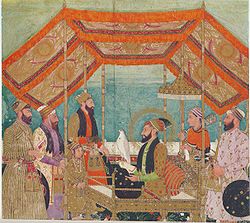Muhammad Azam Shah
| Azam Shah | ||
|---|---|---|
Badshah Aurangzeb | | |
| Born | 28 June 1653 Burhanpur, Deccan Plateau, Mughal Empire | |
| Died | 20 June 1707 (aged 53) Agra, Agra, Mughal Empire | |
| Burial | , India | |
| Consort | ||
| Wives | ||
Hanafi ) | ||
Mughal emperors | ||||||||
|---|---|---|---|---|---|---|---|---|
|
||||||||
Mirza Abu'l Fayaz Qutb-ud-Din Mohammad Azam (28 June 1653 – 20 June 1707), commonly known as Azam Shah, was briefly the seventh
Azam was appointed as the
Early life
Birth
Qutb-ud-Din Muhammad Azam was born on 28 June 1653 in
Azam's other half-brothers, Shah Alam (later Bahadur Shah I) and Muhammad Kam Bakhsh being the sons of Hindu wives of Aurangzeb.[10] According to Niccolao Manucci, the courtiers were very impressed by Azam's royal Persian ancestry and the fact that he was the grandson of Shah Nawaz Khan Safavi.[11]
Character

As Azam grew up, he was distinguished for his wisdom, excellence, and chivalry.
Personal life
Azam was first married on 13 May 1668 to an Ahom princess, Ramani Gabharu, whose name was changed to Rahmat Bano Begum. She was the daughter of the Ahom king, Swargadeo Jayadhwaj Singh, and the marriage was a political one.[citation needed]
On 3 January 1669, Azam married his cousin, Princess Jahanzeb Bano Begum, the daughter of his eldest uncle Crown Prince Dara Shikoh and his beloved wife Nadira Bano Begum.[citation needed]
Jahanzeb was his chief wife and his favorite wife, whom he loved dearly. She gave birth to her eldest son on 4 August 1670. His grandfather Aurangzeb named him 'Bidar Bakht'. Aurangzeb, throughout his life, always loved the three of Azam and Jahanzeb (who is his favorite daughter-in-law) and Prince Bidar Bakht, a brave and successful general. Bidar Bakht was also Aurangzeb's favorite grandson.[citation needed]
Azam's third marriage was fixed with Iran Dukht Rahmat Bano (Pari Bibi), daughter of Aurangzeb's maternal uncle Shaista Khan. However, the marriage could not take place due to the sudden death of Pari Bibi in Dhaka in 1678. In her memory, a mazar (mausoleum) was constructed in Fort Aurangabad (now Lalbagh Fort) in Dhaka.
As part of a political alliance, Azam later married his third (and last) wife, Shahar Bano Begum (Padshah Bibi), in 1681. She was a princess of the Adil Shahi dynasty and the daughter of the ruler Ali Adil Shah II. Despite Bijapur and his other marriages, Azam's love for Jahanzeb remained unchanged. Because when she died in 1705, he was filled with great sadness and despair which darkened the rest of his life.
Siege of Bijapur

In the year 1685 Aurangzeb dispatched his son Muhammad Azam Shah with a force of nearly 50,000 men to capture Bijapur Fort and defeat Sikandar Adil Shah the ruler of Bijapur who refused to be a vassal. The Mughals led by Muhammad Azam Shah could not make any advancements upon Bijapur Fort mainly due to the superior usage of cannon batteries on both sides. Outraged by the stalemate Aurangzeb himself arrived on 4 September 1686 and commanded the Siege of Bijapur after eight days of fighting and the Mughals were victorious.[citation needed]
Subahdar of Bengal
Prince Azam was appointed the governor (
He later became the governor of Gujarat from 1701 to 1706.
Accession
In third week of February 1707 in a bid to prevent a war of succession, Aurangzeb separated Azam and his younger half-brother, Kam Baksh, whom Azam particularly loathed. He sent Azam to Malwa and Kam Baksh to Bijapur. A few days before his death he wrote farewell letters to Azam. The next morning, Azam who had tarried outside
Ancestry
| Ancestors of Muhammad Azam Shah | ||||||||||||||||||||||||||||||||||||||||||||||||||||||||
|---|---|---|---|---|---|---|---|---|---|---|---|---|---|---|---|---|---|---|---|---|---|---|---|---|---|---|---|---|---|---|---|---|---|---|---|---|---|---|---|---|---|---|---|---|---|---|---|---|---|---|---|---|---|---|---|---|
| ||||||||||||||||||||||||||||||||||||||||||||||||||||||||
Full title
Padshah-i-Mumalik Abu'l Faaiz Qutb-ud-Din Muhammad Azam Shah-i-Ali Jah Ghazi
References
- ISBN 9780429757778.
- ^ Sir Jadunath Sarkar (1925). Anecdotes of Aurangzib. M.C. Sarkar & Sons. p. 21.
- ^ Sarkar, Sir Jadunath (1912). History of Aurangzib Vol. I (PDF). Calcutta: M.C. Sarkar & Sons. p. 71.
- ^ Eraly, Abraham (2007). The Mughal World: Life in India's Last Golden Age. Penguin Books India. p. 147.
- ^ Chandra, Satish (2002). Parties and politics at the Mughal Court, 1707–1740. Oxford University Press. p. 50.
- ^ Koch, Ebba (1997). King of the world: the Padshahnama. Azimuth Ed. p. 104.
- ^ Nath, Renuka (1990). Notable Mughal and Hindu women in the 16th and 17th centuries A.D. New Delhi: Inter-India Publ. p. 148.
- ^ Annie Krieger-Krynicki (2005). Captive princess: Zebunissa, daughter of Emperor Aurangzeb. Oxford University Press. p. 1.
- ^ Sarkar, Sir Jadunath (1916). History of Aurangzib: First half of the reign, 1658–1681. M.C. Sarkar & sons. p. 54.
- ^ Sir Jadunath Sarkar (1933). Studies in Aurangzib's reign: (being Studies in Mughal India, first series). Orient Longman. p. 43.
- ISBN 9780195798371.
- ^ Elliot, Henry Miers (1959). The History of India: 1959 Volume 30 of The History of India: As Told by Its Own Historians; the Muhammadan Period; the Posthumous Papers of H. M. Elliot, Sir Henry Miers Elliot. Susil Gupta (India) Private. p. 48.
- ^ Sarkar, Sir Jadunath (1974). History of Aurangzib: mainly based on Persian sources, Volume 5. Orient Longman. p. 219.
- ^ Saqi Musta'idd Khan, Jadunath Sarkar (1947). Maasir-i-'Alamgiri: A History of the Emperor Aurangzib-'Alamgir. Royal Asiatic Society of Bengal. p. 320.
- ^ a b c Karim, Abdul (2012). "Muhammad Azam, Prince". In Islam, Sirajul; Jamal, Ahmed A. (eds.). Banglapedia: National Encyclopedia of Bangladesh (Second ed.). Asiatic Society of Bangladesh.
- ISBN 9780141001432.
- ^ "Mughal dynasty".
- ^ "World Heritage Sites – Ellora Caves – Khuldabad". Archaeological Survey of India. Archived from the original on 6 May 2015. Retrieved 15 April 2015.
